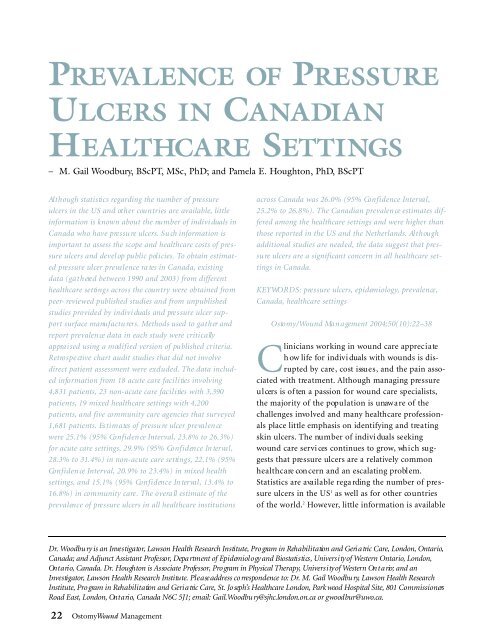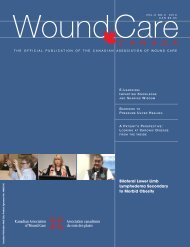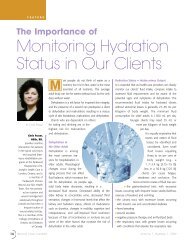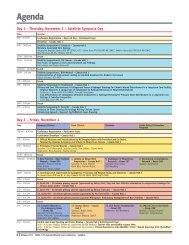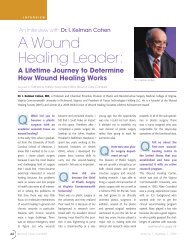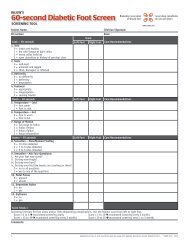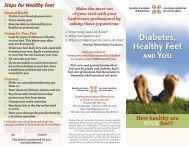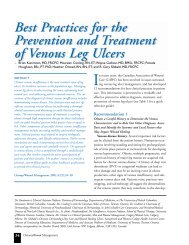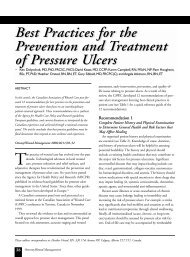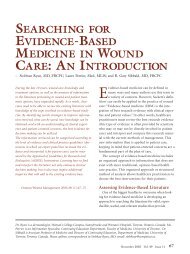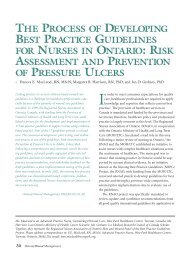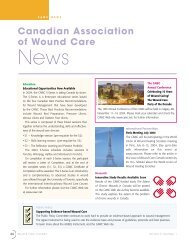M. Gail Woodbury, BScPT, MSc, PhD - Canadian Association of ...
M. Gail Woodbury, BScPT, MSc, PhD - Canadian Association of ...
M. Gail Woodbury, BScPT, MSc, PhD - Canadian Association of ...
Create successful ePaper yourself
Turn your PDF publications into a flip-book with our unique Google optimized e-Paper software.
PREVALENCE OF PRESSURE<br />
ULCERS IN CANADIAN<br />
HEALTHCARE SETTINGS<br />
– M. <strong>Gail</strong> <strong>Woodbury</strong>, <strong>BScPT</strong>, <strong>MSc</strong>, <strong>PhD</strong>; and Pamela E. Houghton, <strong>PhD</strong>, <strong>BScPT</strong><br />
Al t h ou gh stati s ti cs rega rding the nu m ber <strong>of</strong> pre s su re<br />
u l cers in the US and ot h er cou n tries are ava i l a bl e , l i t t l e<br />
i n fo rm a tion is known about the nu m ber <strong>of</strong> i n d ivi duals in<br />
Canada who have pre s su re ulcers . Su ch info rm a tion is<br />
i m po rtant to assess the scope and healthcare costs <strong>of</strong> pre ssu<br />
re ulcers and devel op pu blic pol i ci e s . To obtain esti m a ted<br />
pre s su re ulcer preva l en ce ra tes in Canada, exi s ti n g<br />
data (ga t h ere d betwe en 1990 and 2003) from differen t<br />
h e a l t h c a re set ti n gs across the cou n try were obt a i n ed fro m<br />
pe er- revi ewed pu bl i s h ed studies and from unpu bl i s h ed<br />
s tudies provi d ed by indivi duals and pre s su re ulcer su ppo<br />
rt su rf a ce manu f a ctu rers . Met h ods used to ga t h er and<br />
repo rt preva l en ce data in each stu dy were cri ti c a lly<br />
a ppra i sed using a mod i f i ed version <strong>of</strong> pu bl i s h ed cri teri a .<br />
Retro s pe ctive ch a rt audit studies that did not involve<br />
d i re ct pa ti ent asse s s m ent were excl u d ed . The data incl u ded<br />
info rm a tion from 18 acute care faci l i ties involvi n g<br />
4,831 pa ti en t s , 23 non-acute care faci l i ties with 3,390<br />
pa ti en t s , 19 mixed healthcare set ti n gs with 4,200<br />
pa ti en t s , and five co m mu n i ty care agen cies that su rveyed<br />
1,681 pa ti en t s . Es ti m a tes <strong>of</strong> pre s su re ulcer preva l en ce<br />
were 25.1% (95% Co n f i d en ce In terva l , 23.8% to 26.3%)<br />
for acute care set ti n gs , 29.9% (95% Co n f i d en ce In terva l ,<br />
28.3% to 31.4%) in non-acute care set ti n gs , 22.1% (95%<br />
Co n f i d en ce In terva l , 20.9% to 23.4%) in mixed health<br />
set ti n gs , and 15.1% (95% Co n f i d en ce In terva l , 13.4% to<br />
16.8%) in co m mu n i ty care . The overa ll esti m a te <strong>of</strong> t h e<br />
preva l en ce <strong>of</strong> pre s su re ulcers in all healthcare insti tu ti o n s<br />
22 OstomyWound Management<br />
a cross Canada was 26.0% (95% Co n f i d en ce In terva l ,<br />
25.2% to 26.8%). The <strong>Canadian</strong> preva l en ce esti m a tes differed<br />
among the healthcare set ti n gs and were high er than<br />
t h o se repo rted in the US and the Net h erl a n d s . Al t h ou gh<br />
a d d i tional studies are need ed , the data su ggest that pre ssu<br />
re ulcers are a significant co n cern in all healthcare setti<br />
n gs in Canada.<br />
K EYWO R D S : pre s su re ulcers , ep i d em i ol o gy, preva l en ce ,<br />
C a n a d a , h e a l t h c a re set ti n gs<br />
O s to my / Wound Ma n a gem ent 2004;50(10):22–38<br />
Clinicians working in wound care apprec i a te<br />
h ow life for indivi duals with wounds is disru<br />
pted by care , cost issu e s , and the pain assoc<br />
i a ted with tre a tm en t . Al t h o u gh managing pre s su re<br />
u l cers is <strong>of</strong> ten a passion for wound care spec i a l i s t s ,<br />
the majori ty <strong>of</strong> the pop u l a ti on is unaw a re <strong>of</strong> t h e<br />
ch a ll en ges invo lved and many healthcare pr<strong>of</strong>e s s i onals<br />
place little em phasis on iden ti f ying and tre a ti n g<br />
skin ulcers . The nu m ber <strong>of</strong> i n d ivi duals see k i n g<br />
wound care servi ces con ti nues to grow, wh i ch su ggests<br />
that pre s su re ulcers are a rel a tively com m on<br />
h e a l t h c a re con cern and an escalating probl em .<br />
S t a ti s tics are ava i l a ble rega rding the nu m ber <strong>of</strong> pre ssu<br />
re ulcers in the US 1 as well as for other co u n tri e s<br />
<strong>of</strong> the worl d . 2 However, little inform a ti on is ava i l a bl e<br />
Dr. Wood bu ry is an Inve s ti ga to r, Lawson Health Re se a rch In s ti tu te , Pro gram in Reh a bi l i t a tion and Geri a tric Care , Lo n d o n , On t a ri o,<br />
Canada; and Ad j u n ct Assistant Pr<strong>of</strong>e s so r, Depa rtm ent <strong>of</strong> Ep i d em i ol o gy and Biostati s ti cs , Un ivers i ty <strong>of</strong> We s tern On t a ri o, Lo n d o n ,<br />
On t a ri o, C a n a d a . Dr. Hou gh ton is As so ci a te Pr<strong>of</strong>e s so r, Pro gram in Physical T h era py, Un ivers i ty <strong>of</strong> We s tern On t a rio; and an<br />
Inve s ti ga to r, Lawson Health Re se a rch In s ti tu te . Pl e a se address co rre s po n d en ce to: Dr. M . <strong>Gail</strong> Wood bu ry, Lawson Health Re se a rch<br />
In s ti tu te , Pro gram in Reh a bi l i t a tion and Geri a tric Care , St . Jo sep h’s He a l t h c a re Lo n d o n , Pa rk wood Hospital Si te , 801 Co m m i s s i o n ers<br />
Road Ea s t , Lo n d o n , On t a ri o, Canada N6C 5J1; email: Ga i l . Wood bu ry@sjhc.london.on.ca or gwood bu r @ uwo. c a .
a bo ut the nu m ber <strong>of</strong> i n d ivi duals in Ca n ada wh o<br />
h ave pre s su re ulcers . Na ti onal esti m a tes for the nu mber<br />
<strong>of</strong> pre s su re ulcers in va rious healthcare set ti n gs<br />
in regi ons ac ross Ca n ada are non ex i s ten t . Wi t h o ut<br />
this inform a ti on , e s ti m a ting costs to the Ca n ad i a n<br />
h e a l t h c a re sys tem assoc i a ted with managing ch ron i c<br />
wounds is not po s s i bl e .<br />
Pre s su re ulcers are not nati on a lly recogn i zed as an<br />
i m portant healthcare probl em in Ca n ad a . Cu rren t ly,<br />
little nati onal or provincial funding is ava i l a ble to<br />
provi de coord i n a ted healthcare del ivery progra m s<br />
for their preven ti on and managem ent or to prom o te<br />
the devel opm ent <strong>of</strong> edu c a ti onal programs for healthc<br />
a re pr<strong>of</strong>e s s i on a l s . Fu rt h erm ore , n a ti on a lly funded<br />
grants to su pport re s e a rch programs for iden ti f yi n g<br />
the underlying cause <strong>of</strong> ch ronic wounds and establishing<br />
new interven ti ons and innova tive healthcare<br />
del ivery models are ra re . To focus nati onal atten ti on<br />
and re s o u rces on this serious and growing healthcare<br />
probl em in Ca n ad a , n a ti onal aw a reness abo ut pre ssu<br />
re ulcers must be ra i s ed . G a t h ering facts and stati stical<br />
data that de s c ri be the ex tent <strong>of</strong> the probl em in<br />
Ca n ada is essen tial to the su ccess <strong>of</strong> l obbying healthc<br />
a re ad m i n i s tra tors and govern m ent <strong>of</strong>ficials and for<br />
i n forming the gen eral Ca n adian pop u l a ti on abo ut<br />
the ex tent <strong>of</strong> the probl em .<br />
Recen t ly, the Na ti onal Pre s su re Ul cer Advi s ory<br />
Pa n el (NPUAP) com p l eted a large stu dy de s c ri bi n g<br />
the preva l en ce <strong>of</strong> pre s su re ulcers in the US. 3 In<br />
Ca n ad a , m a ny nati onal or ga n i z a ti ons that<br />
su pport other com m on disease con d i ti on s<br />
su ch as diabete s , c a rd i ovascular disease,<br />
and cancer have inve s ted sign i f i c a n t<br />
human and financial re s o u rces to devel op<br />
and maintain large nati onal regi s tri e s .<br />
Cl e a rly, ga t h ering this inform a ti on is no<br />
s m a ll task. It takes ye a rs to or ga n i ze , co ll<br />
ect , and co ll a te the data.<br />
G iven the en orm i ty <strong>of</strong> the task, t h e<br />
a ut h ors bel i eved an important first step<br />
was to sys tem a ti c a lly search and iden ti f y<br />
ex i s ting data on the preva l en ce <strong>of</strong> pre s su re<br />
u l cers in Ca n ad a . S pec i f i c a lly, the goal <strong>of</strong><br />
this proj ect was to determ i n e , f rom current<br />
ava i l a ble inform a ti on , the preva l en ce<br />
<strong>of</strong> pre s su re ulcers in different care set ti n gs<br />
in regi ons ac ross Ca n ad a . Preva l en ce refers to the<br />
proporti on <strong>of</strong> a group (pati ents not ulcers) that has a<br />
pre s su re ulcer at a given single point in time or ti m e<br />
peri od du ring wh i ch the cases are co u n ted . A cro s s -<br />
s ecti onal stu dy is the appropri a te de s i gn for determining<br />
the nu m ber <strong>of</strong> p a ti ents with pre s su re ulcers<br />
f rom the nu m ber <strong>of</strong> p a ti ents assessed .<br />
Met h ods<br />
Data co ll ecti on . Bet ween Ja nu a ry 2003 and<br />
Novem ber 2003, a ll ava i l a ble data from preva l en ce<br />
s tudies con du cted bet ween 1990 and 2003 were co ll<br />
ected . Several sources for loc a ting studies on the<br />
preva l en ce <strong>of</strong> pre s su re ulcers in all healthcare setti<br />
n gs and in the gen eral pop u l a ti on were inve s ti ga ted<br />
, i n cluding peer- revi ewed publ i s h ed report s ,<br />
u n p u bl i s h ed stu d i e s , and wound care com p a ny datab<br />
a s e s . For studies in wh i ch preva l en ce could be sep ara<br />
ted by fac i l i ty or fac i l i ty type , e ach fac i l i ty or fac i l ity<br />
type was tre a ted as a disti n ct stu dy.<br />
Sys tem a tic com p uter and manual searches <strong>of</strong><br />
l i bra ry databases Pu b Med (Medl i n e ® ) and CINA H L ®<br />
were con du cted using the key words u l cers, C a n a d a,<br />
and preva l en ce to loc a te studies invo lving all healthc<br />
a re set ti n gs and pop u l a ti ons publ i s h ed in peerrevi<br />
ewed journ a l s . Few publ i s h ed arti cles de s c ri bi n g<br />
the preva l en ce <strong>of</strong> pre s su re ulcers in Ca n ada were<br />
fo u n d . Af ter loc a ting the arti cl e s , a ll referen ces were<br />
revi ewed and re s e a rch ers in this field were con t acted<br />
Ostomy/Wound Management 2004;50(10):22–38<br />
KEY POINTS<br />
• The problem <strong>of</strong> pressure ulcers spans the continuum <strong>of</strong><br />
healthcare settings and affects a wide variety <strong>of</strong> healthcare<br />
pr<strong>of</strong>essionals.<br />
• To obtain nationwide pressure ulcer prevalence estimates, the<br />
authors obtained published and unpublished prevalence data<br />
obtained in Canada between 1990 and 2003 using actual skin<br />
assessments.<br />
• The overall prevalence rate was high (26%) with higher rates<br />
(29%) in non-acute and lower rates (15%) in community care<br />
settings.<br />
• The differences between these findings and those reported<br />
from other countries warrant further examination because<br />
they may be the result <strong>of</strong> study methodology or patient/care<br />
differences.<br />
October 2004 Vol. 50 Issue 10 23
TABLE 1<br />
QUESTIONS FOR CRITICA L LY APPRAISING STUDIES OF<br />
P R E VALENCE OF PRESSURE ULCERS IN A HEALTH SETTING<br />
A.Are the study methods valid?<br />
1. Is the sample random or the whole population surveyed?<br />
2. Is the study design prospective? Is a physical examination performed?<br />
3. Is the sample size adequate (>300 subjects)?<br />
4 . A re objective, s u i t a b l e,s t a n d a rd methods used for measurement <strong>of</strong> pre s s u re ulcers?<br />
5. Is the outcome measured in an unbiased fashion?<br />
6. Is the response rate adequate? Are the refusers described?<br />
B. What is the interpretation <strong>of</strong> the results?<br />
7. Are the estimates <strong>of</strong> prevalence given with confidence intervals?<br />
8. Are the estimates <strong>of</strong> prevalence given in detail by subgroups?<br />
C. What is the applicability <strong>of</strong> the results?<br />
9. Are the study subjects and the setting described in detail and similar to those <strong>of</strong><br />
interest to you?<br />
Each question is scored 0 (no) or 1 (yes) to yield a Methodological Score ranging from 0-9.<br />
to loc a te peer- revi ewed arti cles that might have been<br />
m i s s ed .<br />
Ma ny mem bers <strong>of</strong> the Ca n adian As s oc i a ti on for<br />
Wound Ca re (CAWC) re s pon ded to a gen eral web s i te<br />
request for inform a ti on and provi ded unpubl i s h ed<br />
Ca n adian stu dy data. Approx i m a tely 50 people were<br />
con t acted ; <strong>of</strong> ten , the search for studies requ i red cont<br />
act with several people before the correct con t act<br />
was made .<br />
Several wound care companies have large databases<br />
<strong>of</strong> preva l en ce and/or inciden ce studies perform ed<br />
as a servi ce for their custom ers . One com p a ny,<br />
Ki n etic Con cept s , In c . ( KCI Medical Ca n ad a , In c . ,<br />
Mi s s i s s a u ga , O n t a rio) ex pen ded great ef fort to cont<br />
act indivi dual con su m ers to ad d ress propri et a ry and<br />
con f i den ti a l i ty issues in order to share this va lu a bl e<br />
i n form a ti on . The re sults <strong>of</strong> i n d ivi dual studies condu<br />
cted in Ontario and Quebec were made ava i l a bl e .<br />
In ad d i ti on , a ggrega te data (wi t h o ut fac i l i ty names<br />
and wi t h o ut pati ent inform a ti on) were provi ded by<br />
KCI and Hi ll - Rom Ca n ada (Mi s s i s s a u ga , O n t a ri o ) .<br />
D ef i n i ti ons and cri tical app ra i s a l . Because <strong>of</strong><br />
regi onal differen ces and recent ch a n ges in term i n o l ogy,<br />
the term n o n - a c u te care has been used in this<br />
report to inclu de the fo ll owing types <strong>of</strong> c a re set ti n g :<br />
su b ac ute care , ch ronic care , com p l ex con ti nu i n g<br />
c a re , l on g - term care (LTC ) , and nu rsing hom e . Th e<br />
24 OstomyWound Management<br />
term m i x ed health set ti n gs<br />
refers to preva l en ce stu dies<br />
in set ti n gs that con s i s t<br />
<strong>of</strong> a mixtu re <strong>of</strong> ac ute ,<br />
n on - ac ute and/or commu<br />
n i ty care healthcare<br />
del ivery model s ; t h e<br />
preva l en ce esti m a te is<br />
ex pre s s ed overa ll ra t h er<br />
than bro ken down by specific<br />
set ting type .<br />
The met h odo l ogy used<br />
to co ll ect preva l en ce<br />
i n form a ti on in all stu d i e s ,<br />
p u bl i s h ed and unpubl<br />
i s h ed , was cri ti c a lly<br />
a ppra i s ed using a mod if<br />
i ed vers i on <strong>of</strong> recomm<br />
en ded cri teria for eva lua<br />
ting preva l en ce stu d i e s . 4 The ori ginal cri ti c a l<br />
a ppraisal work by Lon ey et al 4 rel a tes to pati ents wi t h<br />
dem en tia and consists <strong>of</strong> a series <strong>of</strong> qu e s ti ons that<br />
a re more appropri a te for health probl ems that can be<br />
eva lu a ted using pop u l a ti on su rveys than for ch ron i c<br />
wo u n d s , wh i ch are gen era lly eva lu a ted in healthcare<br />
f ac i l i ty set ti n gs . Hen ce , it was nece s s a ry to mod i f y<br />
the qu e s ti ons to ref l ect the most com m on stu dy situa<br />
ti ons in wh i ch pati ents in healthcare fac i l i ties were<br />
eva lu a ted , <strong>of</strong> ten by physical ex a m i n a ti on over a rel atively<br />
short ti m e . The cri tical appraisal qu e s ti on s<br />
u s ed in the pre s ent report are listed in Ta ble 1.<br />
The aut h ors indepen den t ly determ i n ed a met h odo<br />
l ogical score for each stu dy by assigning each <strong>of</strong> t h e<br />
nine nu m bered qu e s ti ons a score <strong>of</strong> one (1) point if<br />
a ppropri a te met h ods were used . The final met h odo<br />
l ogical score for each stu dy was obt a i n ed by cons<br />
en su s , with high er score studies repre s en ting more<br />
a ppropri a te and ri gorous re s e a rch met h ods and less<br />
po ten tial bias in the re su l t s . Th erefore , preva l en ce<br />
e s ti m a tes from studies with high er met h odo l ogi c a l<br />
s cores can be accepted with more con f i den ce .<br />
Q u e s ti ons 2, 4 , and 5 <strong>of</strong> the cri tical appraisal (see<br />
Ta ble 1) were the most vi t a l . S tudies were con s i dered<br />
to lack va l i d i ty if: 1) re s ponses indicated that skin<br />
u l cers were co u n ted by met h ods other than direct<br />
physical skin assessmen t , 2) outcome measu res used
Number <strong>of</strong> studies received<br />
Number <strong>of</strong> facilities<br />
Total number <strong>of</strong> patients<br />
Years studies conducted<br />
Sample size:<br />
Mean<br />
Minimum - maximum<br />
Methodological score 0-9<br />
Mean<br />
Range<br />
Number <strong>of</strong> excluded studies<br />
( S c o re
References<br />
Foster et al,<br />
1 9 9 2 7<br />
H a rrison et al,<br />
1 9 9 6 8<br />
Fisher et al, 1 9 9 6 9<br />
McNaughton &<br />
1 0 B r a z i l , 1 9 9 5<br />
Nicolle et al,<br />
1 2 1 9 9 4<br />
D ' h o o re et al,<br />
1 3 1 9 9 7<br />
D avis & Caseby,<br />
1 1 2 0 0 1<br />
Subjects<br />
N=2,384 from thre e<br />
teaching hospitals, o n e<br />
c o m munity hospital, t wo<br />
long-term care facilities,<br />
t wo community health<br />
agencies in Ontario<br />
N=738 from acute care<br />
740-bed facility in<br />
O n t a r i o<br />
N=1,020 from two acute<br />
c a re hospitals in Ontario<br />
N=210 and 202 from one<br />
facility in Ontario<br />
N= 198 and 259 from two<br />
long-term care facilities in<br />
O n t a r i o<br />
N=13,555 from long-term<br />
c a re facilities in Quebec,<br />
except psychiatric or<br />
t o t a l ly private centers<br />
N= 95 and 92 from two<br />
long-term care facilities in<br />
O n t a r i o<br />
28 OstomyWound Management<br />
TABLE 3<br />
PUBLISHED CANADIAN STUDIES<br />
Design/method<br />
Patients assessed over 1 day, one skin<br />
care committee nurse/unit as surveyor,<br />
surveyors trained<br />
Patients assessed within 12-hour period<br />
(skin breakdown, risk); conducted<br />
midweek to reflect accurate mix <strong>of</strong><br />
admissions and case types, in<br />
September to avoid seasonal fluctuations.<br />
Education workshop; survey<br />
team trained, validated; 10% reliability<br />
checked<br />
Patients assessed within 12-hour period<br />
(skin breakdown, risk) by survey<br />
teams <strong>of</strong> RNs. Study conducted midweek<br />
to reflect mix <strong>of</strong> new admissions<br />
and long stay operative cases.<br />
ET therapists available for difficult to<br />
classify ulcers<br />
Pre and post intervention. 2-week period<br />
prevalence: Survey <strong>of</strong> all patients<br />
by nurses to locate ulcers; ulcer physical<br />
assessment using standard form<br />
Prospective surveillance for 2-year<br />
period. Patients with decubiti identified<br />
at the beginning <strong>of</strong> the study period;<br />
surveillance and data collection<br />
including microbiological studies by<br />
study nurse who visited the facility at<br />
least twice per week. Residents with<br />
ulcers followed until ulcer healed, discharge,<br />
or death, or participation termination<br />
Retrospective analysis <strong>of</strong> administrative<br />
data set for year 1993-1994.<br />
“Required nursing time measurement<br />
tool” identified nursing actions<br />
required. Pressure ulcer existence<br />
inferred from evaluation <strong>of</strong> required<br />
nursing actions, treatment <strong>of</strong> pressure<br />
sores; distinction between Stage I and<br />
Stage II versus Stage II and Stage IV<br />
Patients assessed by KCI member, one<br />
facility nurse, one healthcare<br />
aide/team, on 1 day, standard procedures<br />
for presence and number <strong>of</strong><br />
ulcers<br />
Facility<br />
type<br />
Overall<br />
Acute care<br />
Extended care<br />
Community<br />
agencies<br />
Acute care<br />
Acute care<br />
Chronic care<br />
Long-term<br />
care<br />
Long-term<br />
care<br />
Long-term<br />
care<br />
P re v a l e n c<br />
e<br />
25.7<br />
27<br />
30<br />
13<br />
29.7<br />
(95% CI<br />
26.4-33.0)<br />
23.9<br />
Year 1:32.4<br />
Year 2: 22.3<br />
2.8 and 3.5<br />
4.0<br />
36.8 and<br />
53.2<br />
Data<br />
source<br />
Clinical<br />
Clinical<br />
Clinical<br />
Clinical<br />
Clinical<br />
Database<br />
Clinical<br />
Metho<br />
d score<br />
6.5<br />
8<br />
8<br />
5<br />
2<br />
2<br />
7
Figure 1<br />
Prevalence by methodological score in non-acute care.<br />
m et h ods (eg, s t a n d a rd def i n i ti ons <strong>of</strong> pre s su re ulcer<br />
pre s en ce and staging) to en su re that assessmen t s<br />
were done rel i a bly and wi t h o ut bi a s . 8 , 9 These two<br />
s tudies produ ced preva l en ce esti m a tes <strong>of</strong> 29.7% and<br />
2 3 . 9 % , re s pectively.<br />
The on ly Ca n adian stu dy esti m a ting the preval<br />
en ce <strong>of</strong> pre s su res ulcers in a ch ronic care fac i l i ty in<br />
O n t a rio was con du cted before 1995, with pre and<br />
post wound care pro tocol eva lu a ti on s . 1 0 The stu dy ’s<br />
m et h odo l ogical score <strong>of</strong> 5 was affected by the rel atively<br />
small sample size and by the fact that pati en t s<br />
with ulcers were iden ti f i ed<br />
b a s ed on pati ent su rvey<br />
re s ponses obt a i n ed by the<br />
nu rses before direct phys ical<br />
ex a m i n a ti on .<br />
The stu dy <strong>of</strong> pre s su re<br />
u l cers in LTC with the<br />
h i ghest met h odo l ogi c a l<br />
s core (7) produ ced high<br />
e s ti m a tes <strong>of</strong> preva l en ce —<br />
36.8% and 56.2%. 1 1 A lower<br />
e s ti m a te was obt a i n ed in<br />
a n o t h er LTC stu dy in wh i ch<br />
u l cers were assessed using<br />
n on - s t a n d a rd measu re s . 1 2 A<br />
t h i rd stu dy in LTC , wh i ch<br />
was not con du cted pri m a rily<br />
to determine preva l en ce ,<br />
c re a ted an unfavora bl e<br />
30 OstomyWound Management<br />
Study<br />
Ontario 1a<br />
Ontario 2<br />
Ontario 3<br />
Nova Scotia 1<br />
British Columbia 1a<br />
Newfoundland 1<br />
Ontario 4<br />
British Columbia 2<br />
KCI 4<br />
KCI 5<br />
KCI 11<br />
s i tu ati on . S pec i f i c a lly,<br />
the Quebec LTC database<br />
was analy zed<br />
retro s pectively to<br />
determine the rel ati<br />
onship bet ween<br />
pre s en ce <strong>of</strong> pre s su re<br />
s ores and nu rs i n g<br />
work l oad . 1 3 The use<br />
<strong>of</strong> a retro s pective<br />
a n a lysis ra t h er than a<br />
c ro s s - s ecti onal stu dy<br />
de s i gn provi ded an<br />
i m perfect situ a ti on<br />
for determ i n i n g<br />
preva l en ce bec a u s e<br />
s pecific data on the pre s en ce <strong>of</strong> pre s su re ulcers were<br />
not recorded . The pre s en ce <strong>of</strong> pre s su re ulcers was<br />
i n ferred from an eva lu a ti on <strong>of</strong> requ i red nu rs i n g<br />
acti ons for the tre a tm ent <strong>of</strong> pre s su re ulcers . The retro<br />
s pective stu dy de s i gn and non s t a n d a rd measu rem<br />
ent <strong>of</strong> o utcome advers ely affected the met h odo l ogical<br />
score obt a i n ed in the cri tical appra i s a l . Th e s e<br />
t wo latter studies had poor met h odo l ogy scores and<br />
were exclu ded from the su m m a ry data.<br />
Un p u bl i s h ed studies. Th i rty - t h ree unpubl i s h ed<br />
s tudies were received from 19 peop l e . O f t h e s e , 3 0<br />
TABLE 4<br />
P R E VALENCE ESTIMAT E : ACUTE CA R E *<br />
Year<br />
1990<br />
1993<br />
1994<br />
1995<br />
1997<br />
2002<br />
1998<br />
2000<br />
2002<br />
2000<br />
2002<br />
Sample<br />
size<br />
1,525<br />
738<br />
1,020<br />
233<br />
58<br />
203<br />
135<br />
250<br />
133<br />
112<br />
424<br />
Methodologic<br />
al score 0-9<br />
6.5<br />
8<br />
8<br />
5<br />
5<br />
5<br />
6<br />
5<br />
7<br />
7<br />
7<br />
Prevalenc<br />
e<br />
27<br />
29.7<br />
23.9<br />
26.2<br />
15.5<br />
4.9<br />
26.7<br />
34.8<br />
18.8<br />
34.8<br />
16.3<br />
Prevalenc<br />
e<br />
13.6<br />
9.4<br />
17.0<br />
*Sample size, methodological score, and prevalence estimates <strong>of</strong> individual published,<br />
unpublished and KCI clinical studies<br />
These studies were numbered within each province; letters were applied to studies represented<br />
in different settings.
were accepted for use in<br />
this report . In clu ded wi t h<br />
the unpubl i s h ed stu d i e s<br />
were 11 indivi dual stu d i e s<br />
provi ded by a com p a ny —<br />
t h ree repre s en ting ac ute<br />
c a re and ei ght repre s en ting<br />
non - ac ute care . All<br />
u n p u bl i s h ed studies were<br />
c ri ti c a lly eva lu a ted and the<br />
re sults com bi n ed with the<br />
p u bl i s h ed stu d i e s .<br />
Af ter excluding the<br />
s tudies with scores <strong>of</strong> 2 or<br />
less and those with negative<br />
answers to the three<br />
key met h odo l ogical qu e sti<br />
on s , the mean met h odo<br />
l ogical scores for the publ<br />
i s h ed and unpubl i s h ed<br />
s tudies ac ross the fo u r<br />
h e a l t h c a re set ti n gs ra n ged<br />
f rom 5.6 to 6.6 (maximu m<br />
= 9) (see Ta ble 2).<br />
Prev a l en ce esti m a te s .<br />
E s ti m a tes <strong>of</strong> preva l en ce<br />
f rom studies with poorer<br />
m et h odo l ogical score s<br />
ten ded to be lower than<br />
e s ti m a tes obt a i n ed from<br />
s tudies in wh i ch bias was<br />
con tro ll ed (see Figure 1).<br />
Th erefore , s tudies wi t h<br />
s cores 2 were exclu ded .<br />
The preva l en ce estim<br />
a tes <strong>of</strong> the indivi du a l<br />
p u bl i s h ed , u n p u bl i s h ed ,<br />
and KCI studies were<br />
su m m a ri zed for ac ute<br />
c a re , n on - ac ute care , com mu n i ty, and mixed health<br />
s et ti n gs (see Ta bles 4 to 7, re s pectively ) . The overa ll<br />
mean preva l en ce for the healthcare set ti n gs ra n ged<br />
f rom 15.1% (95% CI, 13.4% to 16.8%) in com mu n ity<br />
care , to 29.9% (95% CI, 29.3% to 31.4%) in non -<br />
ac ute care , with mixed health set ting at 22.1% (95%<br />
C I , 20.9% to 23.4%) and ac ute care at 25.1% (95%<br />
32 OstomyWound Management<br />
Study<br />
TABLE 5<br />
P R E VALENCE ESTIMAT E : N O N - ACUTE CA R E *<br />
Ontario 5a<br />
Ontario 5b<br />
Ontario 6<br />
Ontario 1b<br />
Nova Scotia 2<br />
Newfoundland 2<br />
British Columbia 3<br />
British Columbia 4<br />
British Columbia 1b<br />
British Columbia 1c<br />
KCI 1<br />
KCI 2<br />
KCI 3<br />
KCI 6<br />
KCI 7<br />
KCI 8<br />
KCI 9<br />
KCI 10<br />
Year<br />
2000<br />
2000<br />
1993<br />
1990<br />
1995<br />
2002<br />
2000<br />
2000<br />
1997<br />
1997<br />
2002<br />
2003<br />
2002<br />
1999<br />
2001<br />
2002<br />
2001<br />
2002<br />
Sample<br />
size<br />
95<br />
92<br />
210<br />
768<br />
206<br />
143<br />
136<br />
120<br />
229<br />
143<br />
142<br />
65<br />
157<br />
92<br />
142<br />
180<br />
231<br />
239<br />
Methodologic<br />
al score 0-9<br />
7<br />
7<br />
5<br />
6.5<br />
6<br />
5<br />
5<br />
5<br />
7<br />
7<br />
7<br />
7<br />
7<br />
7<br />
7<br />
7<br />
7<br />
7<br />
Prevalenc<br />
e<br />
36.8<br />
53.3<br />
32.4<br />
30.0<br />
31.6<br />
4.2<br />
13.2<br />
16.7<br />
10.9<br />
5.6<br />
39.4<br />
29.2<br />
20.4<br />
53.3<br />
26.1<br />
43.3<br />
41.6<br />
51.0<br />
Prevalenc<br />
e<br />
13.1<br />
*Sample size, methodological score, and prevalence estimates <strong>of</strong> individual published,<br />
unpublished and KCI clinical studies<br />
These studies were numbered within each province; letters were applied to studies represented<br />
in different settings.<br />
TABLE 6<br />
P R E VALENCE ESTIMAT E : COMMUNITY CA R E *<br />
Study Year Sample Methodologic Prevalenc Prevalenc<br />
size al score 0-9 e<br />
e<br />
Ontario 1c<br />
British Columbia 1d<br />
Saskatchewan 1<br />
Manitoba 1<br />
1990<br />
1997<br />
2001<br />
2003<br />
91<br />
29<br />
95<br />
1,466<br />
6.5<br />
6<br />
3.5<br />
6.5<br />
13.2<br />
24.1<br />
15.8<br />
15.0<br />
*Sample size, methodological score, and prevalence estimates <strong>of</strong> individual published,<br />
unpublished and KCI clinical studies<br />
These studies were numbered within each province; letters were applied to studies represented<br />
in different settings.<br />
C I , 23.8% to 26.3%) (see Figure 2). The 95% con f iden<br />
ce limits for each esti m a te were narrow (less than<br />
t wo percen t a ge points from the esti m a te ) , ref l ecti n g<br />
the large sample sizes that re su l ted from the com bin<br />
a ti on <strong>of</strong> s tu d i e s . Convers ely, a large ra n ge <strong>of</strong> va lu e s<br />
was noted bet ween the minimum and maximu m<br />
e s ti m a tes reported for the pre s su re ulcer preva l en ce
Study<br />
TABLE 7<br />
P R E VALENCE ESTIMAT E : MIXED HEALTH SETTINGS*<br />
Ontario 1d<br />
Ontario 7<br />
Ontario 8<br />
British Columbia 5<br />
Nova Scotia 3<br />
British Columbia 1e<br />
Year<br />
1990<br />
2001<br />
1998<br />
1996<br />
1995<br />
1997<br />
Figure 2<br />
Estimates <strong>of</strong> pressure ulcer prevalence in various healthcare settings (95% Confidence<br />
Interval bars).<br />
Figure 3<br />
Acute care prevalence: KCI Studies 1997-2002.<br />
34 OstomyWound Management<br />
Sample<br />
size<br />
2384<br />
406<br />
310<br />
202<br />
439<br />
459<br />
Methodologic<br />
al score 0-9<br />
6.5<br />
7<br />
7<br />
6<br />
6<br />
6<br />
Prevalenc<br />
e<br />
25.7<br />
13.1<br />
21.6<br />
10.9<br />
28.7<br />
10.7<br />
Prevalenc<br />
e<br />
11.0<br />
9.4<br />
13.5<br />
-<br />
11.2<br />
6.7<br />
*Sample size, methodological score and prevalence estimates <strong>of</strong> individual published,<br />
unpublished and KCI clinical studies<br />
These studies were numbered within each province; letters were applied to studies represented<br />
in different settings.<br />
<strong>of</strong> e ach i n d ivi dual stu dy.<br />
Because the con f i den ce<br />
limits for different healthc<br />
a re set ti n gs do not overl<br />
a p, the esti m a tes in these<br />
s et ti n gs are sign i f i c a n t ly<br />
d i f feren t . Wh en all data<br />
a re com bi n ed to report<br />
overa ll preva l en ce (rega rdless<br />
<strong>of</strong> s et ting and avoi d i n g<br />
repre s en ting stu dy data<br />
m ore than on ce ) , the mean<br />
preva l en ce is high er at<br />
26% (95% CI, 2 5 . 2 -<br />
2 6 . 8 % ) , b a s ed on 10,911 su bj ect s .<br />
Aggrega te data prev a l en ce<br />
e s ti m a te s . KCI provi ded ye a rly<br />
preva l en ce esti m a tes for 61 ac ute<br />
c a re fac i l i ties from studies condu<br />
cted from 1997 to 2003.<br />
Because similar re s e a rch met hods<br />
were used to co ll ect these<br />
preva l en ce esti m a te s , t h ey can be<br />
com p a red over time (see Figure<br />
3 ) . E s ti m a tes <strong>of</strong> pre s su re ulcer<br />
preva l en ce were found to<br />
dec rease gradu a lly from 42% in<br />
1997 to 29% in 2002.<br />
Re sults <strong>of</strong> preva l en ce stu d i e s<br />
con du cted by Hi ll - Rom in 35<br />
ac ute and non - ac ute Ca n ad i a n<br />
f ac i l i ties — ie, m i xed healthcare<br />
s et ti n gs — from 2001 to 2003<br />
produ ced a preva l en ce esti m a te <strong>of</strong><br />
14.9% based on 6,828 pati en t s .<br />
D i s c u s s i on<br />
This proj ect provi ded rel i a bl e<br />
e s ti m a tes <strong>of</strong> pre s su re ulcer preval<br />
en ce for four healthcare set ti n gs<br />
in Ca n ad a . The esti m a te s , wh i ch<br />
h ave narrow con f i den ce interva l s ,<br />
a re based on indivi dual stu d i e s<br />
that were cri ti c a lly appra i s ed and<br />
found to be met h odo l ogi c a lly<br />
s o u n d , yi elding large com bi n ed<br />
samples from ac ross the co u n try
for most healthcare fac i l i ty type s .<br />
The preva l en ce esti m a tes obt a i n ed and a de s i red<br />
n a rrow 95% CI width <strong>of</strong> 10% can be used to ascert a i n<br />
the sample size requ i rem ents for con du cting a futu re<br />
preva l en ce stu dy in each <strong>of</strong> the healthcare setti n gs ,<br />
using the formula su gge s ted by Ba u m ga rten . 5 (Th e<br />
accept a n ce <strong>of</strong> a 95% CI wi der than 10% re sults is a<br />
trade - <strong>of</strong> f in prec i s i on for a small er sample size<br />
requ i rem ent.) The requ i red sample size esti m a te s<br />
a re : 289 ac ute care su bj ect s , 322 non - ac ute care su bj<br />
ect s , 197 com mu n i ty care su bj ect s , and 265 mixed<br />
h e a l t h c a re su bj ect s . In other word s , in set ti n gs in<br />
wh i ch the preva l en ce is anti c i p a ted to be above 25%,<br />
a pprox i m a tely 300 su bj ects are needed , while fewer<br />
su bj ects are needed if the preva l en ce is anti c i p a ted to<br />
be as low as 15%. These sample size calculati ons len d<br />
su pport to the met h odo l ogical cri teri on su gge s ted by<br />
Lon ey et al 4 that appropri a te sample size for preval<br />
en ce studies is gre a ter than 300 su bj ects to all ow for<br />
the po s s i bi l i ty that the preva l en ce is as high as 25%.<br />
Com p a ring esti m a tes with those from other co u ntries<br />
su ggests that the esti m a te for the nu m ber <strong>of</strong><br />
p a ti ents with pre s su re ulcers in ac ute care (25.1%) is<br />
h i gh er than two previ o u s ly reported pre s su re ulcer<br />
preva l en ce esti m a tes from ac ross the US. 1 , 3 Th e<br />
N P UAP pre s su re ulcer preva l en ce esti m a te ra n ged<br />
bet ween 10% and 17.1%. 3 Wh i t ti n g ton et al 1 reported<br />
a 15.1% preva l en ce <strong>of</strong> pre s su re ulcers from a seri e s<br />
<strong>of</strong> s tudies con du cted by KCI in ac ute care fac i l i ti e s<br />
ac ross the US. The differen ces bet ween Ca n adian and<br />
US esti m a tes <strong>of</strong> preva l en ce <strong>of</strong> pre s su re ulcers in<br />
ac ute care fac i l i ties might be due to differen t<br />
m et h odo l ogies em p l oye d and the time peri od over<br />
wh i ch the data were co ll ected . However, US and<br />
Ca n adian esti m a tes gen era ted by KCI in 1999 using<br />
i den tical met h ods found a pre s su re ulcer preva l en ce<br />
e s ti m a te in Ca n ada <strong>of</strong> 27% (see Figure 3) that was<br />
con s i dera bly high er than the 15.1% va lue reported in<br />
U S . 1 Th erefore , these esti m a tes may repre s ent tru e<br />
d i f feren ces bet ween the Ca n adian and US healthcare<br />
s ys tem s . Ot h er po s s i ble ex p l a n a ti ons inclu de differen<br />
ces in the sample sizes and pati ent pr<strong>of</strong> i l e s . The US<br />
KCI esti m a te reported by Wh i t ti n g ton was limited to<br />
adult pati ents in med i c a l - su r gical and inten s ive care<br />
u n i t s , while samples su rveyed in Ca n adian healthcare<br />
i n s ti tuti ons in this report inclu ded more units.<br />
The stu dy preva l en ce esti m a te for pati ents in non -
ac ute care fac i l i ties in Ca n ada (29%) is close to the upper va lue in<br />
the ra n ge reported by the NPUA P, 2.3% to 28%, 3 and to another<br />
recen t ly publ i s h ed preva l en ce esti m a te (28%). 1 4 Horn et al 1 4 u s ed a<br />
retro s pective co h ort sample <strong>of</strong> 2,420 pati ents who were at risk <strong>of</strong><br />
devel oping pre s su re ulcers as indicated by Braden scores <strong>of</strong> 17 or<br />
l e s s . One would have ex pected the current esti m a tes for pre s su re<br />
u l cer preva l en ce in all pati ents within Ca n adian non - ac ute care fac i li<br />
ties to be mu ch high er than esti m a tes from the US that ex a m i n ed<br />
on ly pati ents who had alre ady been iden ti f i ed as at risk <strong>of</strong> devel oping<br />
pre s su re ulcers . Di f feren ces bet ween current esti m a tes in Ca n ad a<br />
and US pre s su re ulcer preva l en ce esti m a tes may be due to the use <strong>of</strong><br />
d i f ferent met h odo l ogies — the US stu dy used retro s pective analys i s<br />
ra t h er than direct skin ex a m i n a ti on from wh i ch the Ca n adian estim<br />
a tes in this report were derived . The aut h ors found that stu d i e s<br />
that used retro s pective data analysis received lower met h odo l ogi c a l<br />
s cores and ten ded to produ ce lower preva l en ce esti m a te s ; t h erefore ,<br />
these studies may be more likely to undere s ti m a te true preva l en ce <strong>of</strong><br />
pre s su re ulcers .<br />
Di f feren ces bet ween Ca n adian and US esti m a tes <strong>of</strong> pre s su re ulcer<br />
preva l en ce also may be ex p l a i n ed by the fact that the term n o n - a c u te<br />
c a re en compasses a po ten ti a lly diverse pop u l a ti on . The de s c ri ptors<br />
for healthcare fac i l i ties with non - ac ute pati ents have ch a n ged over<br />
the past several ye a rs and are not uniform in different regi ons ac ro s s<br />
Ca n ad a . Th ey inclu de LTC , nu rsing hom e s , com p l ex con ti nuing care ,<br />
s k i ll ed nu rsing fac i l i ti e s , reh a bi l i t a ti on , and geri a tri c s . Because <strong>of</strong> t h e<br />
va rying term i n o l ogy, the re sults were com bi n ed into a gen eric category:<br />
n on - ac ute care . It is po s s i ble that the true preva l en ce in any<br />
p a rticular su b group within this cl a s s i f i c a ti on may be masked by this<br />
h e a l t h c a re set ti n g’s divers i ty.<br />
The national estimate <strong>of</strong> pressure ulcer prevalence in Canada (26%)<br />
is slightly higher than the estimate reported from a national study done<br />
in the Netherlands and considerably higher than the international<br />
aggregate estimate for 2003 provided by Hill-Rom. The epidemiological<br />
study performed in the Netherlands examined 16,344 patients and produced<br />
an overall estimate <strong>of</strong> 23.1% for all the health settings. 2 The international<br />
estimate from Hill-Rom was 15.5%, based on 61,427 surveyed<br />
patients in 461 facilities <strong>of</strong> all types. The majority <strong>of</strong> these Hill-Rom<br />
international studies were conducted in the US.<br />
Li m i t a ti ons<br />
The divers i ty <strong>of</strong> the non - ac ute care pop u l a ti on that was com bi n ed<br />
for the pre s ent proj ect may have re su l ted in an esti m a te for this<br />
gen eric sample that is not acc u ra te for any <strong>of</strong> the su b gro u p s , ( eg,<br />
LTC fac i l i ti e s , nu rsing hom e s , com p l ex con ti nuing care , s k i ll ed nu rsing<br />
fac i l i ti e s , reh a bi l i t a ti on , and geri a tri c s ) .<br />
Most stu d i e s , p u bl i s h ed and unpubl i s h ed , reported insu f f i c i en t<br />
i n form a ti on to answer all the met h odo l ogical qu e s ti ons abo ut the
s tu d i e s . Some gaps in inform a ti on were fill ed by<br />
ad d i ti onal con t acts with proj ect aut h ors but wh en<br />
the inform a ti on was not ava i l a ble or aut h ors co u l d<br />
not be con t acted , it was assu m ed that ri gorous met hods<br />
were not perform ed or that certain re sults were<br />
not obt a i n ed .<br />
The data obt a i n ed do not repre s ent all data co ll<br />
ected from Ca n adian healthcare set ti n gs . No estim<br />
a tes <strong>of</strong> preva l en ce in ac ute and non - ac ute care<br />
came from the Pra i rie Provi n ce s ; t h erefore , one mu s t<br />
a s sume that the preva l en ce <strong>of</strong> pre s su re ulcers in these<br />
t wo set ti n gs would be similar in these provi n ce s . Th e<br />
i n form a ti on received is on ly a sample from rel a tively<br />
few insti tuti ons ac ross Ca n ad a . It is po s s i ble that<br />
f ac i l i ties el ecting to do preva l en ce studies do so wh en<br />
t h ey su s pect a po ten tial probl em and this might contri<br />
bute to the high er preva l en ce reported in rel a ti on<br />
to other co u n tri e s .<br />
All pressure ulcer prevalence estimates obtained for<br />
this project are within the healthcare sector; no national<br />
estimate was secured for the general population.<br />
Several national databases, such as the National<br />
Population Health Survey (NPHS), were reviewed in<br />
vain to find a statistic for the population.<br />
Con clu s i on<br />
This proj ect provi des preva l en ce esti m a tes for<br />
pre s su re ulcers in va rious Ca n adian healthcare setti<br />
n gs <strong>of</strong> 15% to 30%, and an overa ll esti m a te <strong>of</strong> 2 6 % .<br />
These esti m a tes seem to be high er than esti m a te s<br />
f rom the US and the Net h erl a n d s , perhaps because <strong>of</strong><br />
the trend in the Ca n adian healthcare sys tem to limit<br />
hospital ad m i s s i on and redu ce length <strong>of</strong> s t ay; t h ereby,<br />
re su l ting in sicker pati ents within the sys tem .<br />
This inform a ti on wi ll be useful to cl i n i c i a n s ,<br />
re s e a rch ers , and policy makers in Ca n ada and other<br />
co u n tries to advoc a te for the needs <strong>of</strong> p a ti ents wi t h<br />
ch ronic pre s su re ulcers . Ad d i ti onal inform a ti on is<br />
n eeded abo ut the preva l en ce <strong>of</strong> o t h er types <strong>of</strong><br />
wo u n d s . In a recent sys tem a tic revi ew <strong>of</strong> preva l en ce<br />
<strong>of</strong> l ower limb ulcers , the preva l en ce <strong>of</strong> venous leg<br />
u l cers was determ i n ed to be 0.12% to 1.1% based on<br />
the studies that em p l oyed clinical va l i d a ti on <strong>of</strong><br />
u l cers . 1 5 More studies are needed to esti m a te the<br />
nu m ber people in the gen eral pop u l a ti on wi t h<br />
ch ronic wounds <strong>of</strong> a ny cause. - OW M<br />
38 OstomyWound Management<br />
Referen ce s<br />
1. Whittington K, Patrick M, Roberts JL. A national<br />
study <strong>of</strong> pressure ulcer prevalence and incidence in<br />
acute care hospitals. J Wound Ostomy Continence<br />
Nurs. 2000;27(4):209-215.<br />
2. Bours GJ, Halfens RJ, Abu-Saad HH, Grol RT.<br />
Prevalence, prevention, and treatment <strong>of</strong> pressure<br />
ulcers: descriptive study in 89 institutions in the<br />
Netherlands. Res Nurs Health. 2002;25(2):99-110.<br />
3. National Pressure Advisory Panel, Cuddingan J, Ayello<br />
EA, Sussman C, eds. Pressure Ulcers in America:<br />
Prevalence, Incidence, and Implications for the Future.<br />
Reston, Va.: NPUAP;2001.<br />
4. Loney PL, Chambers LW, Bennett KJ, Roberts JG,<br />
Stratford PW. Critical appraisal <strong>of</strong> the health research<br />
literature: prevalence or incidence <strong>of</strong> a health problem.<br />
Chronic Dis Can. 1998;19(4):170-176.<br />
5. Baumgarten M. Designing prevalence and incidence<br />
studies. Adv Wound Care. 1998; 11(6):287-293.<br />
6. Hamilton L, Cleverly S. A skin care resource nurse<br />
program: is it effective? Perspectives. 1994;18(1):10-14.<br />
7. Foster C, Frisch SR, Forler Y, Jago M. Prevalence <strong>of</strong><br />
pressure ulcers in <strong>Canadian</strong> institutions. CAET<br />
Journal. 1992;11(2):23-32.<br />
8. Harrison MB, Wells G, Fisher A, Prince M. Practice<br />
guidelines for the prediction and prevention <strong>of</strong> pressure<br />
ulcers: evaluating the evidence. Appl Nurs Res.<br />
1996;9(1):9-17.<br />
9. Fisher A, Denis N, Harrison MB, et al. Quality management<br />
in skin care: understanding the problem <strong>of</strong><br />
pressure ulcers. <strong>Canadian</strong> Journal <strong>of</strong> Quality in<br />
Healthcare. 1996;13(1):4-11.<br />
10. McNaughton V, Brazil K. Wound and skin team.<br />
Impact on pressure ulcer prevalence in chronic care. J<br />
Gerontol Nurs. 1995;21(2):45-49.<br />
11. Davis CM, Caseby NG. Prevalence and incidence<br />
studies <strong>of</strong> pressure ulcers in two long-term care facilities<br />
in Canada. Ostomy Wound Manage.<br />
2001;47(11):28-34.<br />
12. Nicolle LE, Orr P, Duckworth H, et al. Prospective<br />
study <strong>of</strong> decubitus ulcers in two long-term care facilities.<br />
Can J Infect Control. 1994;9(2):35-38.<br />
13. D’Hoore W, Guisset AL, Tilquin C. Increased nursingtime<br />
requirements due to pressure sores in long-termcare<br />
residents in Quebec. Clinical Performance and<br />
Quality Healthcare. 1997;5(4):189-194.<br />
14. Horn SD, Bender SA, Bergstrom N, et al. Description<br />
<strong>of</strong> the National Pressure Ulcer Long-Term Care Study.<br />
J Am Geriatr Soc. 2002;50(11):1816-1825.<br />
15. Graham ID, Harrison MB, Nelson EA, Lorimer K,<br />
Fisher A. Prevalence <strong>of</strong> lower-limb ulceration: a systematic<br />
review <strong>of</strong> prevalence studies. Adv Skin Wound<br />
Care. 2003;16(6):305-316.


